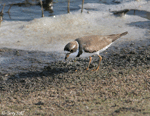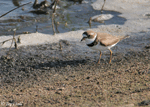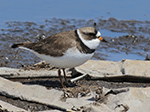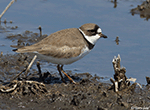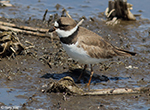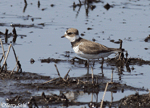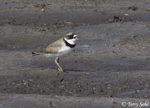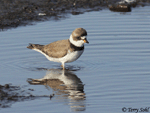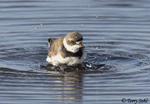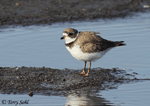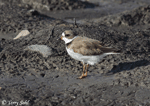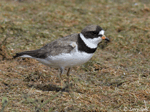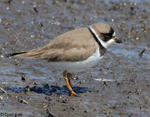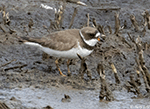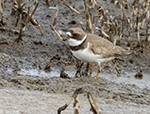Semipalmated Plover
Charadrius semipalmatus
| Length: 7 inches | Wingspan: 14 inches | Seasonality: Migrant |
| ID Keys: Single black neck band, black mask with white above bill, short black-tipped orange bill, yellow-orange legs | ||
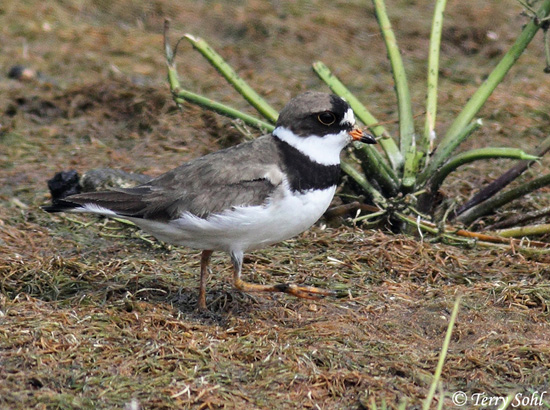 The Semipalmated Plover is the most common of the small plovers
that migrate through the state. The name "Semipalmated" refers
to the partial webbing found between the bird's toes. With a very short
stubby bill, unlike many other
shorebirds that migrate simultaneously as the Semipalmated Plover, they do not
probe in the mud for food items, instead only plucking items from the surface.
They also thus tend to forage more on open mud flats as opposed to the shallow
water habitats preferred by many shorebirds.
The Semipalmated Plover is the most common of the small plovers
that migrate through the state. The name "Semipalmated" refers
to the partial webbing found between the bird's toes. With a very short
stubby bill, unlike many other
shorebirds that migrate simultaneously as the Semipalmated Plover, they do not
probe in the mud for food items, instead only plucking items from the surface.
They also thus tend to forage more on open mud flats as opposed to the shallow
water habitats preferred by many shorebirds.
Habitat:
Prefers very open habitats during migration through the state, such as open mudflats, sandy beaches, or plowed fields. Avoids wetland areas with heavy vegetation. At breeding grounds in northern North America, they prefer sandy or mossy tundra.
Diet:
Insects, earthworms, small mollusks and crustaceans. Also marine worms and various marine animal eggs on wintering grounds.
Behavior:
Usually moves quickly along the shoreline, walking quickly and periodically pausing, grabbing food items when spotted.
Breeding:
Non-breeder in South Dakota. In their breeding range in northern North America, they build a simple scrape nest on the ground, sometimes lined with a bit of vegetation. The female lays 4 eggs, and both parents help to incubate them. After the eggs hatch, the young quickly leave the nest. They are tended to by both parents, but they find their own food.
Song:
Crisp rising chweep or a shorter call note.
- Click here to hear the crisp calls of a Semipalmated Plover1
- Click here to hear the rising chweep calls of a disturbed bird taking flight2
Migration:
Summers in northern Canada and Alaska. Winters along U.S. coasts all the way down through South America.
Interactive eBird Map:
Click here to access an interactive eBird map of Semipalmated Plover sightings
Similar Species:
The plumage patterns of a Semipalmated Plover are similar to some other plover species, while multiple other plovers share the small size of the species.
- Piping Plover - Another very small plover species found in South Dakota, and on occasion the two species could be found in the same habitat and geographic. Piping Plovers are much paler in overall appearance than the Semipalmated Plover. The also have much less extensive black on the head and neck. On a Piping Plover, the black around the neck and upper breast is a thinner band, and doesn't extend completely around the breast (unlike a Semipalmated Plover). Piping Plovers have a thin black band on the forehead above the eyes, while the black on a Semipalmated Plover is thicker and extends through and around the eyes.
- Snowy Plover - Snowy Plovers were considered an extremely rare visitor to South Dakota, with a breeding range south of the state. However, in the 2000s, it was found a number of times and was confirmed as a very rare breeding bird in the state. The two species may occasionally overlap in habitat and geography. Overall, Snowy Plovers are paler than Semipalmated Plovers, and have much less extensive black markings. On a breeding plumaged bird, the black is limited to a thin streak on the neck, a black smudge behind the eye, and a black bar on the upper forehead.
- Wilson's Plover - Not a species that has been found in South Dakota, in their normal range they may sometimes overlap with Semipalmated Plovers and could be confused with them. Wilson's Plovers have a noticeably more robust bill, longer and thicker than a Semipalmated Plover. Black on the neck is concentrated on the front of the bird and trails away to the back, while it's more extensive on a Semipalmated Plover. The head of a Wilson's Plover is brown overall with a white streak above the eye, compared to the black, brown, and white pattern on a Semipalmated Plover.
- Killdeer - The most common plover in the state by far, overall plumage patterns may appear to be similar. However, the size difference is apparent, with Killdeer a much larger bird than Semipalmated Plovers. The bill on a Killdeer is longer than that of a Semipalmated Plover and is completely black. Killdeer have two black bands on the chest and neck, as opposed to the one on a Semipalmated Plover. Killdeer have a white patch behind the eye lacking on a Semipalmated Plover.
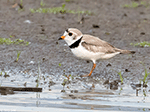 |
 |
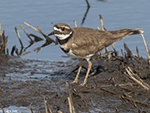 |
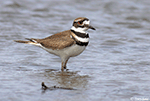 |
| Piping Plover | Piping Plover | Killdeer | Killdeer |
Conservation Status:
Like many of the shorebirds, numbers of Semipalmated Plover were seriously depleted during the 19th century due to hunting. They have since recovered and are now widespread and common, and are also found across a very wide geographic range. Population trends are considered stable and may have been increasingly slightly over recent decades. The IUCN lists the Semipalmated Plover as a species of "Least Concern".
Further Information:
Photo Information:
August 17th, 2013 - Lake County, South Dakota - Terry Sohl
Additional Photos:
Click on the image chips or text links below for additional, higher-resolution Semipalmated Plover photos.
Audio File Credits:
- 1Paul Marvin. Recorded in Brevard County, Florida on May 10th, 2018. Original file and recording from xeno-canto.
- 2Jayrson Araujo De Oliveira. Recorded in Brazil on February 19th, 2018. Original file and recording from xeno-canto.
| Click on the map below for a higher-resolution view |
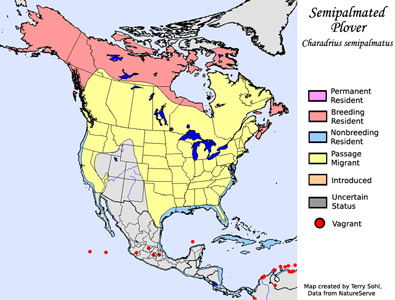 |
| South Dakota Status: Uncommon migrant throughout the state. |
Additional Semipalmated Plover Photos
Click for a higher-resolution version of these photos
